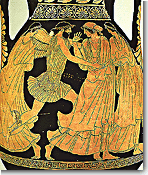





     |
|
|
|
To the second of Aristotle's categories of contractual relations, comprising voluntary exchanges, belonged those that were furtive and violent. The term furtive was applied to all those that were carried out secretively, for instance theft, adultery, witchcraft (pharmakeia), pimping, enticement of slaves (doulapatia), murder, and false witness. The term violent comprised all those that presupposed the use of force, for instance manslaughter, abduction, maiming (perose), slander, insult (aikia) and mudslinging. Theft and adultery were prosecuted by a graphe. For specific cases, indeed, the graphe klopes demosion kai hieron was provided. The graphe was also used to prosecute prodigals, as well as all who showed signs of mental or emotional disturbance (graphe argias kai paranoias). Slander (kakegoria), on the other hand, entailed a dike; so did wounding: dike traumatos ek pronoias or dike blabes. |  |
As far as hybris is concerned, there have been dissenting views these last few years. The traditional view was that whatever insulted the gods was hybris. Certain younger scholars argue, however, that hybris was evidently an illegal act, but of a social, not a religious nature. Seen from this angle, any act that insulted the honour of a citizen would have been hybris. The information we have cannot lead us to a firm view, but we can say with relative certainty that the graphe hybreos - mainly known from Demosthenes - is likely to have been a legislative measure of the Classical period. This is also entailed by the fact that in the Archaic period any activity insulting to someone's honour was covered by the dike aikias.
|
| |
|
Note: Click on a picture for a brief description. | |